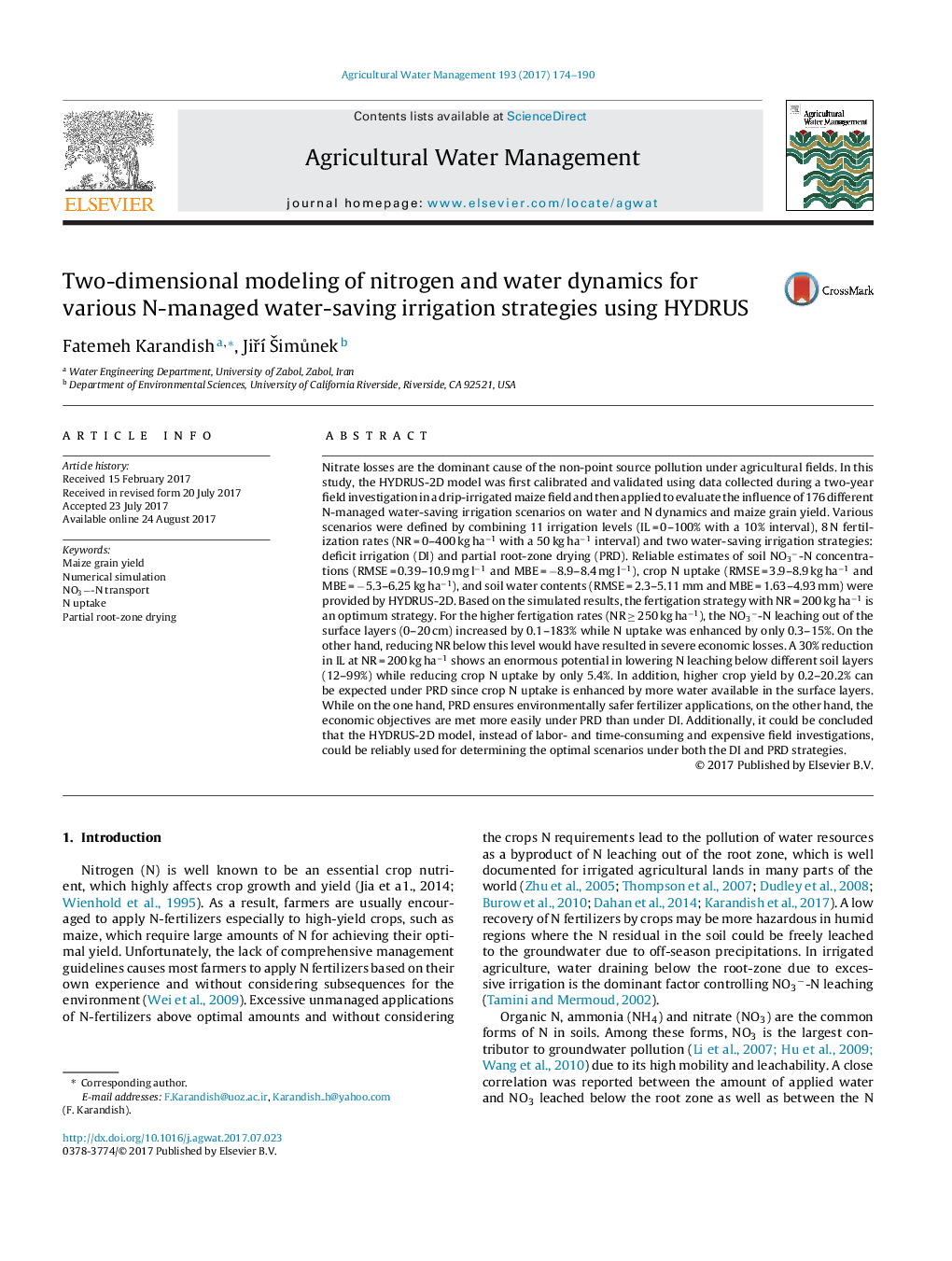| کد مقاله | کد نشریه | سال انتشار | مقاله انگلیسی | نسخه تمام متن |
|---|---|---|---|---|
| 5758269 | 1622887 | 2017 | 17 صفحه PDF | دانلود رایگان |
عنوان انگلیسی مقاله ISI
Two-dimensional modeling of nitrogen and water dynamics for various N-managed water-saving irrigation strategies using HYDRUS
دانلود مقاله + سفارش ترجمه
دانلود مقاله ISI انگلیسی
رایگان برای ایرانیان
کلمات کلیدی
موضوعات مرتبط
علوم زیستی و بیوفناوری
علوم کشاورزی و بیولوژیک
علوم زراعت و اصلاح نباتات
پیش نمایش صفحه اول مقاله

چکیده انگلیسی
Nitrate losses are the dominant cause of the non-point source pollution under agricultural fields. In this study, the HYDRUS-2D model was first calibrated and validated using data collected during a two-year field investigation in a drip-irrigated maize field and then applied to evaluate the influence of 176 different N-managed water-saving irrigation scenarios on water and N dynamics and maize grain yield. Various scenarios were defined by combining 11 irrigation levels (IL = 0-100% with a 10% interval), 8 N fertilization rates (NR = 0-400 kg haâ1 with a 50 kg haâ1 interval) and two water-saving irrigation strategies: deficit irrigation (DI) and partial root-zone drying (PRD). Reliable estimates of soil NO3â-N concentrations (RMSE = 0.39-10.9 mg lâ1 and MBE = â8.9-8.4 mg lâ1), crop N uptake (RMSE = 3.9-8.9 kg haâ1 and MBE = â5.3-6.25 kg haâ1), and soil water contents (RMSE = 2.3-5.11 mm and MBE = 1.63-4.93 mm) were provided by HYDRUS-2D. Based on the simulated results, the fertigation strategy with NR = 200 kg haâ1 is an optimum strategy. For the higher fertigation rates (NR â¥Â 250 kg haâ1), the NO3â-N leaching out of the surface layers (0-20 cm) increased by 0.1-183% while N uptake was enhanced by only 0.3-15%. On the other hand, reducing NR below this level would have resulted in severe economic losses. A 30% reduction in IL at NR = 200 kg haâ1 shows an enormous potential in lowering N leaching below different soil layers (12-99%) while reducing crop N uptake by only 5.4%. In addition, higher crop yield by 0.2-20.2% can be expected under PRD since crop N uptake is enhanced by more water available in the surface layers. While on the one hand, PRD ensures environmentally safer fertilizer applications, on the other hand, the economic objectives are met more easily under PRD than under DI. Additionally, it could be concluded that the HYDRUS-2D model, instead of labor- and time-consuming and expensive field investigations, could be reliably used for determining the optimal scenarios under both the DI and PRD strategies.
ناشر
Database: Elsevier - ScienceDirect (ساینس دایرکت)
Journal: Agricultural Water Management - Volume 193, November 2017, Pages 174-190
Journal: Agricultural Water Management - Volume 193, November 2017, Pages 174-190
نویسندگان
Fatemeh Karandish, JiÅà Šimůnek,